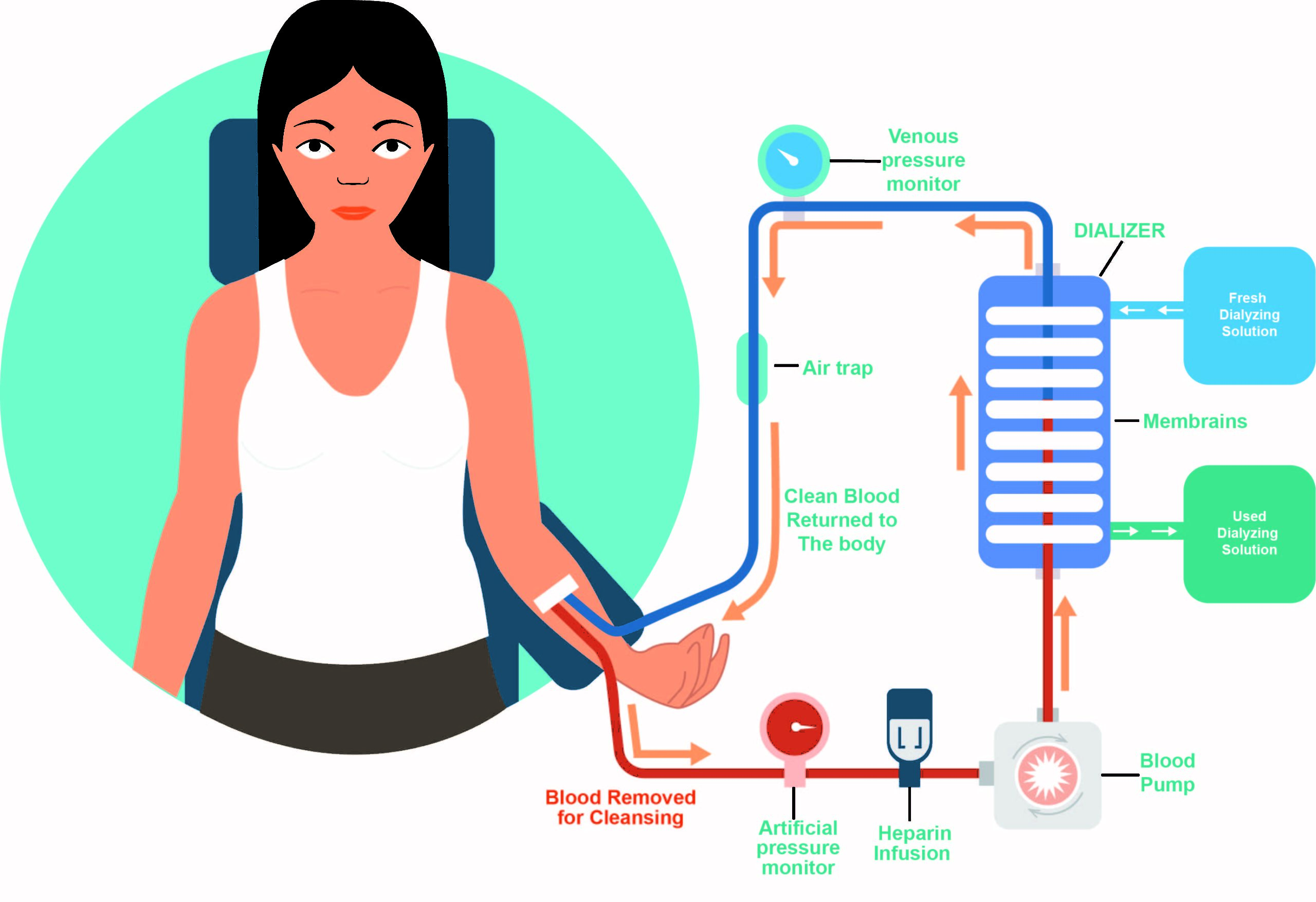Dialysis: Types and Drawbacks
June 19, 2020 | by Yashaswi Pathakamuri | Posted in Nutrition Facts

Dialysis is a procedure that replaces some of the kidney’s normal functions. According to the National Kidney Foundation, end-stage kidney failure occurs when the kidneys are performing at only 10 to 15% of their normal function. This article helps you know about dialysis.
Like healthy kidneys dialysis keeps the body in balance by removing waste products including salt and excess fluids, maintaining a safe level of blood chemicals such as potassium, sodium and chloride in the body and controlling the blood pressure. It is performed when a person experiences kidney failure, usually when more than 95% of normal kidney.
Why is dialysis used?
When your kidneys can’t perform these functions due to disease or injury, dialysis can help keep the body running as normally as possible. Without dialysis, salts and other waste products will accumulate in the blood, poison the body, and damage other organs.
Properly functioning kidneys prevent extra water, waste, and other impurities from accumulating in your body. They also help control blood pressure and regulate the levels of chemical elements in the blood. These elements may include sodium and potassium. Your kidneys even activate a form of vitamin D that improves the absorption of calcium. But dialysis isn’t a cure for kidney disease or other problems affecting the kidneys. Different treatments may be needed to address those concerns.
Why do i need dialysis?
When your kidneys are not working properly – for example, because you have advanced chronic kidney disease (kidney failure) – the kidneys may not be able to clean the blood properly. Waste products and fluid can build up to dangerous levels in your body.
Left or untreated, can cause a number of unpleasant symptoms and eventually be fatal. Dialysis filters out unwanted substances and fluids from the blood before this happens.
How long do i need dialysis?
In some cases, kidney failure may be a temporary problem and dialysis can be stopped when your kidneys recover. It depends on the type of case. But often, some people with kidney failure will need a kidney transplant.
It’s not always possible to carry out a kidney transplant straight away, so dialysis may be needed until a suitable donor kidney becomes available. If a kidney transplant is not suitable for you, because you are not well enough to have a major operation – dialysis may be needed for the rest of your life.
Types
In general, dialysis becomes necessary at a creatinine clearance of 4 to 8 ml per minute or a serum creatinine of about 10 mg per deciliter. There are two basic kinds of dialysis:
- Haemodialysis
- Peritoneal dialysis
Haemodialysis
In this, an artificial kidney, haemodialysis is used to remove the waste products from the blood and restore the body’s chemical balance.
Haemodialysis is the most common type of dialysis and the one most people are aware of. During the procedure, a tube is attached to a needle in your arm. Blood passes along the tube and into an external machine that filters it, before it’s passed back into the arm along another tube.
Peritoneal dialysis
In this type the patient’s blood is cleaned within the body, the blood stays in the blood vessels which line the patients abdominal (peritoneal) space. The lining of the space acts like the membrane in the artificial kidney.
Before treatment starts, a incision (cut) is made near your belly button and a thin tube called a catheter is inserted through the incision and into the space inside your abdomen (the peritoneal cavity). This is left in place permanently. Fluid is pumped into the peritoneal cavity through the catheter. As blood passes through the blood vessels lining the peritoneal cavity, waste products and excess fluid are drawn out of the blood and into the dialysis fluid.
Drawbacks of dialysis
- Dialysis can only control the kidney failure and does not cure the diseased kidney.
- Discomfort is seen when needles are inserted for haemodialysis.
- Patients with chronic kidney failure need to continue dialysis throughout their lives or until they receive a kidney transplantation.
- Patients may also experience a drop in blood pressure accompanied by nausea, vomiting, headache and cramps.
- Dialysis is very expensive.
Recent Posts
Categories
- Arthritis
- B vitamins
- Berries
- Best time to take
- Breasfeeding
- cancer
- Chronic Diseases
- COVID-19
- Dairy
- Deficiency
- Diabetes
- Diet
- Diseases
- FAQ's
- Fats
- Fever
- Hair
- health
- Kidney
- Leafy Vegetables
- Lung disease
- mango
- Meat
- Millets
- Minerals
- Myositis
- Nausea
- Nutrition Facts
- Nuts and Seeds
- Oats and Oatmeal
- Psoriasis
- Recipes
- Rice
- Skin
- spices and Condiments
- Summer
- Thyroid
- Varicose Veins
- Vegetables
- Vitamins
- Vomiting
- water
- weight gain
- weight Loss
Archives
- April 2024
- March 2024
- February 2024
- January 2024
- December 2023
- November 2023
- October 2023
- September 2023
- August 2023
- July 2023
- June 2023
- May 2023
- April 2023
- March 2023
- February 2023
- January 2023
- November 2022
- October 2022
- September 2022
- August 2022
- July 2022
- June 2022
- May 2022
- April 2022
- March 2022
- February 2022
- January 2022
- December 2021
- November 2021
- October 2021
- September 2021
- July 2021
- June 2021
- May 2021
- April 2021
- March 2021
- February 2021
- January 2021
- December 2020
- November 2020
- October 2020
- September 2020
- August 2020
- July 2020
- June 2020
- May 2020
- April 2020
- March 2020
- February 2020
- January 2020